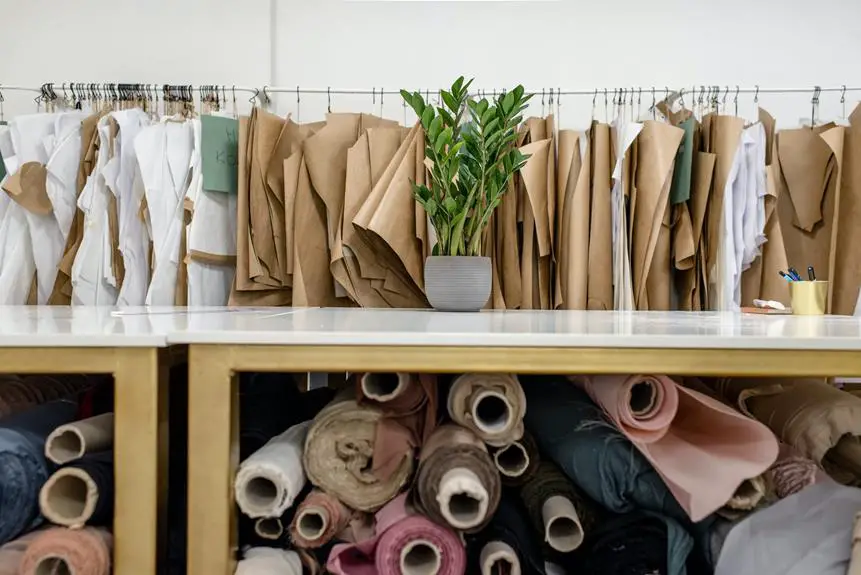You've got a treasure trove of fabric scraps, but finding a clever way to store them can be a bit of a puzzle.
No need to fret, though – we've got you covered with 5 clever ways to keep those scraps organized and ready for your next project.
From clear bins and hanging fabric organizers to a fabric scrap 'library' system, you'll find the perfect storage solution that fits your space and style.
We'll show you how to repurpose everyday items for storage and even set up a vertical file or rack system that will keep your fabric scraps neat and accessible.
Get ready to master the art of fabric scrap storage with these creative ideas!
Key Takeaways
- Clear bins and containers provide visibility and accessibility for organizing fabric scraps by color.
- Hanging fabric organizers maximize space and keep fabric scraps easily accessible.
- Implementing a fabric scrap 'library' system with labeled bins simplifies finding specific scraps and helps assess available materials.
- Repurposing old jars, furniture, and creative shelving solutions offer practical and aesthetically pleasing storage options for fabric scraps.
Clear Bins and Containers
You can easily organize your fabric scraps by using clear bins and containers to keep them visible and accessible. Clear bins provide an efficient solution for fabric scrap organization, allowing you to see the contents without having to open each container. This makes it easier to locate specific colors, patterns, or textures when working on your next project.
One creative idea is to sort your fabric scraps by color and place them in separate clear bins. This way, you can quickly identify the color you need without rummaging through a jumbled mess. Additionally, you can label the bins with the color names for even easier access.
Another creative approach is to use stackable clear containers, which optimize space and keep your fabric scraps neatly contained.
Furthermore, clear bins are excellent for storing fabric scraps of different sizes and shapes. You can use smaller containers for tiny scraps and larger ones for bigger pieces, ensuring that nothing gets lost or overlooked.
Hanging Fabric Organizers
Hanging fabric organizers offer efficient storage solutions for fabric scraps, maximizing space and keeping your materials easily accessible. These organizers come in various designs, from pocketed panels to hanging baskets, allowing you to neatly store and display your fabric scraps. With the scraps visible and within reach, you can easily find inspiration for fabric scrap art and DIY fabric scrap projects.
The clear pockets or compartments in hanging fabric organizers make it simple to sort scraps by color, pattern, or size, aiding in the quick selection of materials for your next creative endeavor.
When using hanging fabric organizers, consider grouping your fabric scraps based on potential projects. For instance, you might organize a panel with scraps ideal for quilting projects, while another panel could hold scraps suitable for smaller DIY fabric scrap projects like patchwork coasters or fabric-covered buttons. This method not only keeps your workspace tidy but also sparks creativity as you visualize the possibilities for each fabric scrap.
Fabric Scrap 'Library' System
Consider creating a fabric scrap 'library' system by categorizing and storing your scraps in labeled bins or containers. This approach will help you easily locate and use your fabric scraps for future projects.
Here are three key steps to implement this system effectively:
- Color Coded Organization: Sort your fabric scraps by color and store them in clear containers or bins. Use color-coded labels to easily identify the contents, making it simple to find the specific fabric scraps you need for a project.
- Fabric Scrap Inventory: Keep a detailed inventory of your fabric scraps, noting the type of fabric, size, and quantity. This will help you quickly assess what you have on hand and avoid purchasing unnecessary materials for your projects.
- Efficient Storage: Utilize stackable containers or bins to maximize space and keep your fabric scrap 'library' organized. Consider using shelving units or a designated storage area to house your categorized fabric scraps.
Implementing a fabric scrap 'library' system with color-coded organization, maintaining a fabric scrap inventory, and efficient storage will streamline your creative process and make the most of your fabric scraps.
Repurposed Storage Solutions
For repurposed storage solutions, repurpose old jars and containers to neatly store your fabric scraps. Not only does it help you organize your sewing space, but it also gives a new life to items that would have otherwise been discarded.
Upcycling old furniture is another creative way to store and display your fabric scraps. For instance, you can use an old dresser with drawers to sort fabric pieces by color or size. This not only provides a practical storage solution but also adds a unique touch to your crafting area.
Additionally, consider utilizing creative shelving solutions such as wall-mounted crates or repurposed wooden pallets to store your fabric scraps. These options not only keep your workspace tidy but also serve as aesthetically pleasing decor.
Vertical File or Rack System
Utilize a vertical file or rack system to efficiently store and access your fabric scraps in a space-saving manner. This method is perfect for keeping your fabric scraps organized and easily accessible.
Here are three reasons why a vertical file or rack system is a clever way to store fabric scraps:
- Maximize Space: A vertical file or rack system allows you to make the most of your vertical space, keeping your fabric scraps neatly organized without taking up too much floor space.
- Easy Access: With a vertical file or rack system, you can easily see and access your fabric scraps. This makes it simple to find the perfect scrap for your next project without rummaging through piles of fabric.
- Fabric Scrap Display: By arranging your fabric scraps on a vertical file or rack system, you can create a visually appealing display. This not only looks great but also makes it easy to see all of your available scraps at a glance, inspiring creativity and making it easier to select the right fabric for your next project.
A vertical file or rack system is a practical and visually appealing solution for fabric scrap organization.
Frequently Asked Questions
Can I Use Vacuum-Sealed Bags to Store Fabric Scraps?
You can definitely use vacuum-sealed bags to store fabric scraps. They're a great way to organize and protect your fabric, keeping it compact and easy to find when you need it for your next project.
How Can I Effectively Store Small Fabric Scraps Without Them Getting Lost or Tangled?
To effectively store small fabric scraps without them getting lost or tangled, consider using creative containers and hanging organizers. These solutions help you keep your fabric scraps organized and easily accessible for your crafting projects.
Are There Any Specific Tips for Organizing Fabric Scraps by Color or Pattern?
When organizing fabric scraps by color or pattern, start by sorting them by size. Utilize containers to keep each color or pattern separate and easily accessible. This method will help you maintain a tidy and efficient fabric scrap storage system.
What Are Some Creative Ways to Repurpose Household Items for Fabric Scrap Storage?
You can repurpose containers like mason jars or shoe organizers to store fabric scraps. Get creative with hanging solutions, like using a pegboard or tension rods to display and organize your fabric scraps while saving space.
Is There a Recommended Method for Labeling Fabric Scraps to Easily Identify Them Later On?
To easily identify fabric scraps later on, use a clear organizing system and effective labeling techniques. This will help you quickly locate the specific fabric you need for your projects, making your workflow more efficient.
- The Difference Between Gabardine and Denim Fabric - June 24, 2025
- Why Every Man Needs a Pair of Wool Gabardine Dress Pants - June 24, 2025
- Exploring Burberry’s Tropical Gabardine for Lighter Outerwear - June 24, 2025







